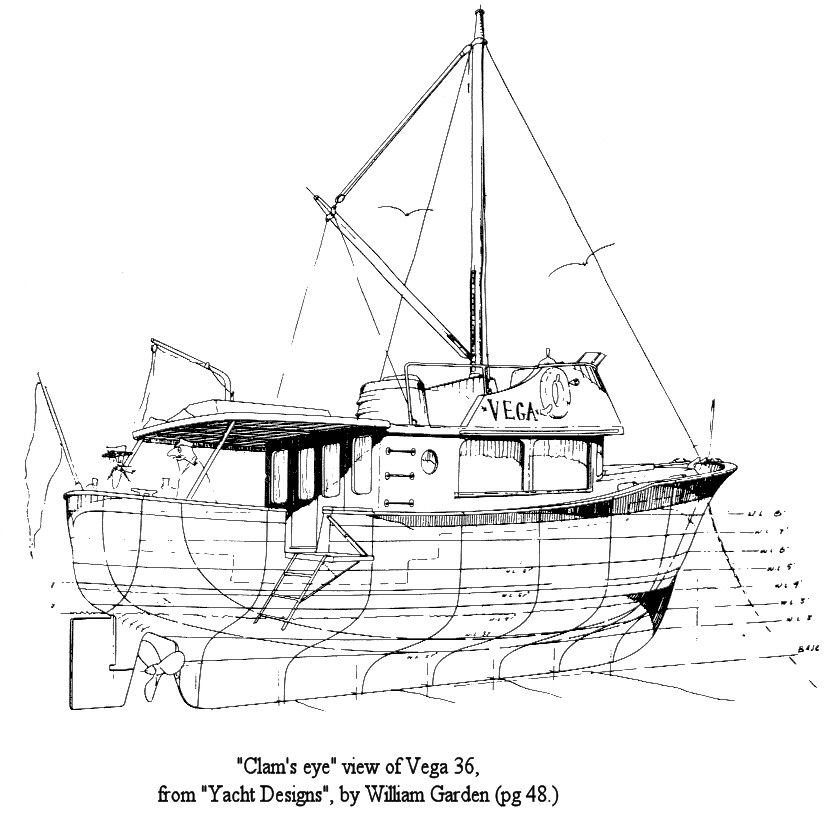
This site contains a database of all known production trawler yachts built by Willard Marine of Costa Mesa, California, USA.
Willard was the first production builder of fiberglass trawler yachts, before Grand Banks, Krogen, or any others. Their boats are sought after by many who are looking for solid, no-nonsense full-displacement cruising boats.
Willard built their last yacht in 2002, but continues to this day producing military and commercial vessels.
Willard History Excerpts from Willard Boat Owners archives:
#17169, 2/14/18:
[Provided by Patrick Gerety, Willard Marine, April 2003]
======================================================Here is the Vega history as related to me by company officials who were with Willard Boat Works at its inception.
Bill Tighe (pronounced "tie") started what eventually became Willard Boat Works, and later Willard Marine, in a vacant lot in Costa Mesa, CA in the 1950's. Bill's trusted right hand man, boatwright, and confidant was Willard Buchanan. Bill eventually named his company after his friend.

In the late '50's a fellow by the name of Ramsey Armstrong approached Bill with a set of plans for a 36 foot trawler that he paid Bill Garden to design. Ramsey owned a company called Vega Marine in Southern California which was primarily a marketing firm. It was sort of like PAE (Pacific Asian Enterprises), the marketing firm for Nordhavns. PAE designs the boats and then contracts with other companies to build them. They don't actually build any boats. This is the same way that Vega Marine operated.
Ramsey contracted with Bill Tighe to build the Garden 36 which was called the Vega 36 as a result of Ramsey's company name. After a few years and several complete boats, Ramsey tired of the project and sold the hull mold (which was built by Bill Tighe but Ramsey owned the rights) to Bill. Bill continued to build the boat (in three different models) and marketed it through his own company, which was then called Willard Boat Works, as the Willard Vega 36.
The Willard Vega 36 project ended in 1970. In 1972, Willard Marine started building a 30 foot trawler in five different models – Searcher (fish boat style), Nomad (Sedan), Horizon motorsailer), Voyager (pilothouse) and Sailboat (cutter rigged). In 1973, a 40 foot trawler in three different models was started – Nomad (flybridge sedan), Voyager (pilothouse), and Motorsailer. It was convenient to keep the Vega designation for continuity and so the boats became the Willard Vega 30 and the Willard Vega 40. All of these Vega boats had solid fiberglass hulls with fiberglass over plywood topsides.
Around 1975/1976 Willard Marine decided to update its tooling with cored fiberglass topsides. Some styling changes were made to the topsides when the tooling was made. Only one model of the 30 was offered at that time, the Willard 30 Flybridge Sedan (sometimes called the Willard 30/4). Two models of the Willard 40 were offered, the W40 Flybridge Sedan and the W40 pilothouse. At that time, 1975/76, the Vega designation and model names were dropped to reflect the new direction of Willard Marine.
In 1999 a Willard 30 Pilothouse was added and in 2001 a new, redesigned Willard 40 Pilothouse.
#9838, 11/16/08 [posted by Richard Miller]:
Willard built a 36 foot boat in three models in the 1960s. The most popular was the Standard Cruiser, a sedan style with elongated cabin and flybridge (28 built). It has a single stateroom forward in the bow with a head. A linear galley is in the saloon to starboard, and it has a huge stern cockpit. Many fine examples remain in use today. 5 Motorsailers and 6 Aft Pilothouse models also were built.

Until 1977 the term "Vega" was used to denote the hull style. It does not identify a model.
The Willard Vega 30 series (Voyager, Searcher, Nomad & Horizon models) were built 1973-75. The Horizon is a motorsailer. Most Willard owners have one of these mid-1970s Vega 30 models (of which a total of 110 were built). The 29 Voyagers were the roomiest, with a saloon running the full width of the boat and contiguous with the raised pilothouse and its sidedeck.
The Vega 30 models then were discontinued and replaced with the Willard 30/4 ("Mark IV"). 28 flybridge sedans were built between 1977 and 2001, derived from the Vega 30 Nomad design. In 1999-2001 two raised pilothouse boats and one “liveaboard” adaptation were built.
In 1975-76 Willard produced 30 of the "8-ton cutters" (an English-style designation), a cutter-rigged sailboat built on a modified Vega 30 hull.
The "Vega 40" was built 1973-77. Three were flybridge sedans in a “widebody” design (without sidedecks). Two were in a raised pilothouse style without a flybridge.
One was custom built as a motor sailer in 1977.
The “new” all-fiberglass Willard 40 was introduced in April 1977 with "many updated features". It was similar to the previous Vega 40 but with sidedecks. Also, the decks and superstructures were cored fiberglass produced from a mold, as in the 30/4, and the term "Vega" was discontinued.
14 were built as the W40 Flybridge Sedan between 1977 and 2001. 6 were built in a pilothouse configuration, the last two in a "new" design in 2001-02.
After 1976 Willard was primarily a commercial and military builder, and remains so today. Due to the crush of military business they terminated the recreational trawler program in September 2003.
[Richard Miller, '74 W30 Vega Voyager Seagull (for sale), W40 Flybridge Sedan Trawler Adria (commissioned 2000)]
Hale Field and Fram - Sea Magazine article, June 1976
An article about Hale Field, who is credited with designing the 30 and 40-foot Willard hulls.





